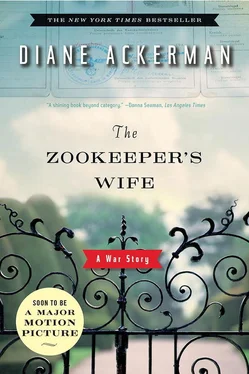“HOW CAN THIS BARBARITY BE HAPPENING IN THE TWENTIETH century?!!!!!!” Antonina asked herself, an outcry of disbelief with no fewer than six exclamation points. “Not long ago the world looked on the dark ages with contempt for its brutality, yet here it is again, in full force, a lawless sadism unpolished by all the charms of religion and civilization.”
Sitting at the kitchen table, she prepared small packets of food for friends in the Ghetto, thankful that no one poked through Jan’s clothing or pails as he went about his regular rounds to collect kitchen scraps for the Weimar’s pig farm. No doubt he enjoyed the irony of carrying food from the pig farm into the Ghetto, and if it felt a little off-color giving Jews pork, a taboo food, dietary laws had long since been waived, and everyone was grateful for protein, a scarce gift on either side of the wall.
In the beginning, neither Jews nor Poles absorbed the full tirade of racist laws or believed the grisly rumors about Jew roundups and killings. “As long as we didn’t witness such events themselves, feel it with our own skin,” Antonina later recalled, “we could dismiss them as otherworldly and unheard-of, only cruel gossip, or maybe a sick joke. Even when a Department of Racial Purity opened a detailed census of the city’s Jewish population, it still seemed possible to attribute such madness to that famous German talent for being systematic and well organized,” the wheel-spinning of bureaucrats. However, Germans, Poles, and Jews stood in three separate lines to receive bread, and rationing was calculated down to the last calorie per day, with Germans receiving 2,613 calories, Poles 669 calories, and Jews only 184 calories. In case anyone missed the point, German Governor Frank declared: “I ask nothing of the Jews except that they disappear.”
Verboten! became a familiar new command, yelled by soldiers, or inked large with the wagged finger of an exclamation point on posters and in anti-Semitic newspapers like Der Stürmer. Ignoring those three syllables was punishable by death. Barked out, the word moved from fricative f to plosive b, from thin-lipped disgust to blown venom.
As warnings and humiliations increased day by day, Jews were forbidden restaurants, parks, public toilets, and even city benches. Branded with a blue star of David on a white arm-band, they were barred from railways and trams, and publicly stigmatized, brutalized, denigrated, raped, and murdered. Edicts forbade Jewish musicians from playing or singing music by non-Jewish composers, Jewish lawyers were disbarred, Jewish civil servants fired without warning or pension, Jewish teachers and travel agents dismissed. Jewish-Aryan marriages or sexual relations were illegal, Jews were forbidden to create art or attend cultural events, Jewish doctors were ordered to abandon their practices (except for a few in the Ghetto). Street names that sounded Jewish were rechristened, and Jews with Aryan-sounding first names had to replace them with “Israel” or “Sarah.” Marriage licenses issued to Poles required a “Fitness to marry” certificate. Jews couldn’t hire Aryans as servants. Cows couldn’t be inseminated by Jewish-owned bulls, and Jews weren’t allowed to raise passenger pigeons. A host of children’s books, like The Poison Mushroom, promoted Nazi ideology with anti-Semitic caricatures.
For sport, soldiers hoisted orthodox Jews onto barrels and scissored off their religious beards, or taunted old men and women, sometimes ordering them to dance or be shot. Archival footage shows strangers waltzing together in the street, holding each other awkwardly, faces sour with fear, as Nazi soldiers clapped and laughed. Any Jew passing a German without bowing and doffing his cap merited a savage beating. The Nazis seized all cash and savings, and stole furniture, jewelry, books, pianos, toys, clothing, medical supplies, radios, or anything else of value. Over 100,000 people, yanked from their homes, endured chronic days of physical labor without pay, and Jewish women, as further humiliation, were forced to use their underwear as cleaning rags on floors and in toilets.
Then, on October 12, 1940, the Nazis ordered all of Warsaw’s Jews from their homes and herded them into a district on the north side of town, which lay conveniently between the main railway station, Saxon Garden, and the Gdańsk railroad terminal. Typically, German soldiers would surround a block and give people half an hour to vacate their apartments, leaving everything behind but a few personal effects. Adding the Jews relocated from the countryside, that edict confined 400,000 people to only 5 percent of the city, about fifteen to twenty square blocks, an area about the size of Central Park, where the sheer racket alone, a “constant tense clamor” as one resident described it, frayed sanity. [33] Michał Grynberg, ed., Words to Outlive Us: Eyewitness Accounts from the Warsaw Ghetto , trans. Philip Boehm (London: Granta Books, 2003), p. 46. At one point Himmler invited Werner Heisenberg to establish an institute to study icy stars because, according to the cosmology of Welteislehre, based on the observations of the Austrian Hanns Hörbiger (author of Glazial-Kosmogonie [1913]), most bodies in the solar system, our moon included, are giant icebergs. A refrigeration engineer, Hörbiger was persuaded by how shiny the moon and planets appeared at night, and also by Norse mythology, in which the solar system emerged from a gigantic collision between fire and ice, with ice winning. Hörbiger died in 1931, but his theory became popular among Nazi scientists and Hitler swore that the unusually cold winters in the 1940s proved the reality of Welteislehre. Nicholas Goodrick-Clarke’s The Occult Roots of Nazism explores the influence of such magnetic lunatics as Karl Maria Wiligut, “the Private Magus of Heinrich Himmler,” whose doctrines influenced SS ideology, logos, ceremonies, and the image of its members as latter-day Knights Templars and future breeding stock for the coming Aryan utopia. To this end, Himmler founded Ahnenerbe, an institute for the study of German prehistory, archaeology, and race, whose staff wore SS uniforms. Himmler also acquired Wewelsburg Castle in Westphalia to use immediately for SS education and pseudoreligious ceremonies, and remodel into a future site altogether more ambitious, “creating an SS Vatican on an enormous scale at the center of the millenarian greater Germanic Reich.”
That vortex of 27,000 apartments, where an average of fifteen people shared two and a half small rooms, served the Nazi goal of grinding down morale, enfeebling, humiliating, and softening up resistance.
Jewish Ghettos had flourished in Europe throughout history, and however remote or disdained, they tended to be vital and porous, allowing travelers, merchants, and culture to flow in both directions. The Warsaw Ghetto differed dramatically, as Michael Mazor, a Ghetto survivor, recalls: “In Warsaw the Ghetto was no longer anything but an organized form of death—a ‘little death chest’ (Todeskätschen), as it was called by one of the German sentries posted at its gates… a city which the Germans regarded as a cemetery.” [34] Michael Mazor, The Vanished City: Everyday Life in the Warsaw Ghetto , trans. David Jacobson (New York: Marsilio Publishers, 1993), p. 19.
Only the crafty and vigilant survived, and no one ventured from home without first checking the danger forecast. Pedestrians updated one another as they passed, and “mere mention of a threat, the slightest gesture, could send a crowd of several thousand back inside, leaving the street empty and bare.” [35] Grynberg, Words to Outlive Us , pp. 46–47.
But life’s weedy tumult still flowered in the Ghetto, however and wherever it could. Norman Davies gives this snapshot of the early Ghetto’s vibrant features: “For two or three years, it was thronged with passers-by, with rickshaws and with its own trams mounted with a blue star of David. It had cafes and restaurants, at number 40 a ‘Soup Kitchen for Writers,’ and places of amusement. The Fotoplastikon at 27 Leszno Street offered a popular eye on the outside world by showing a series of still pictures of exotic places like Egypt, China, or California. A clown with a red nose stood on the pavement, cajoling people to buy a ticket for 6 groszy. At 2 Leszno Street, the Arts Coffee House laid on a daily cabaret and a stream of concerts featuring singers such as Vera G. or Marysdha A., the ‘Nightingale of the Ghetto,’ and musicians such as Ladislas S. and Arthur G. At 35 Leszno Street, the ‘Femina’ music hall mounted more ambitious productions from a wide Polish repertoire including the ‘Princess of the Czardas’ revue, and the aptly named comedy ‘Love Seeks an Apartment.’ It was all a desperate form of escapism. As someone remarked, ‘Humor is the Ghetto’s only form of defence.’” Many of the Ghetto’s best-known streets translated as visions of paradise, plenty, and adventure: Garden Street, Peacock Street, Cool Street, Wild Street, New Linden Street, Dragon Street, Salt Street, Goose Street, Brave Street, Warm Street, Cordials Street, Pleasant Street.
Читать дальше












